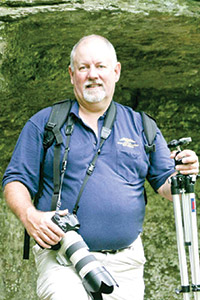AOPA Action
What AOPA is doing to keep you flying
 Fuller urges: ‘Let’s rally GA’
Fuller urges: ‘Let’s rally GA’
AOPA President Craig Fuller called on general aviation pilots to rally around GA so that collectively the industry can protect our freedom to fly. Delivering a keynote address at the Northwest Aviation Conference in Puyallup, Washington, Fuller said everyone has a role to play.
“Every year we get together at AOPA and come up with an idea that encapsulates where we are going and what we hope to accomplish over the course of the year ahead,” he said. “This year, we are going to ‘Rally GA.’ And that means we are going to pull together all of our resources—not just the resources that AOPA can bring to bear, but also the resources of the entire GA community—to support general aviation and protect our freedom to fly.
“It also means we are working with our fellow aviation associations to tackle some of the big challenges facing us, like the future of avgas and what NextGen should look like. And it means we are rallying support in Congress so we will have allies who understand the importance and value of general aviation, and keep GA in mind when they are working through tough issues like FAA reauthorization, transportation priorities, and budgeting.
“We are just now beginning to emerge from the worst economic crisis in 70 years,” said Fuller. “The good news is that we are beginning to see real signs of recovery. Everywhere I go, pilots and aviation companies seem more optimistic than they have in a while.”
Equally challenging is the pilot population, which has declined by approximately 25 percent since its high-water mark in 1980. Fuller highlighted the Flight Training Student Retention Initiative, led by AOPA. Some 60 percent to 80 percent of people who begin flight training drop out before earning a pilot certificate.
Fuller noted some of the other ways that AOPA and its fellow associations are rallying GA: working collaboratively with one another, the FAA, and Environmental Protection Agency to identify the best alternative to 100LL aviation gasoline; developing consensus recommendations for the Next Generation Air Transportation System (NextGen); and supporting the General Aviation Caucuses in the U.S. House of Representatives and Senate.
He also talked about ways that individual pilots can rally GA.
“You can invite newcomers to give flying a try and help them through the training process,” he said. “You can join the nearly 162,000 individual pilots who took part in at least one of the Air Safety Institute’s online courses and quizzes last year.”
Fuller noted that this initiative will take the collaborative efforts of pilots and associations alike. “Your involvement can make a real difference as we rally GA and protect our freedom to fly.”
NATIONAL action

EAA’s Hightower, leadership team visit AOPA
EAA President and CEO Rod Hightower and members of his leadership team spent two days at AOPA’s Frederick, Maryland, headquarters, meeting with AOPA President Craig Fuller and his leadership team, discussing ways the two organizations can work collaboratively to promote general aviation and protect Americans’ freedom to fly.
The teams shared overviews of what each association and its members are doing to support GA and talked about how the two groups can collaborate to enhance those efforts.
“Our theme for 2011 is ‘Rally GA,’ so it’s important that we look for ways the two largest general aviation organizations can work together on behalf of GA,” said Fuller. “We’ve looked at our individual programs and initiatives to see where they align and how we can make them work better for our members and all pilots.”
Hightower added, “EAA’s grassroots chapter system gives us great access at the community level, and AOPA’s members have shown their willingness time and again to stand up and support GA. Our two organizations work diligently to defend our members’ interests, but is there any better ‘sales pitch’ for GA than a pilot sharing his love of flight?”
The meeting is part of the two associations’ ongoing collaboration to support a combined membership of more than half a million, and promote and protect GA.
FAA issues interim residential-through-the-fence rules
The 75 known airports with residential-through-the-fence access can continue with their current agreements, but the airports sponsors must submit detailed access plans to their airports district office or regional airports office for review, according to a new FAA interim rule.
“The interim rule is much different from what was proposed in 2009, which would have banned all existing and future residential-through-the-fence access,” said John Collins, AOPA manager of airport policy. “AOPA spent a lot of time talking with FAA airports staff about the detrimental impact of the 2009 proposal, and we are pleased that our constant engagement paid off. To its credit, the FAA initiated a review, and took a collaborative approach that resulted in significant changes which allow residential access to continue at these airports.”
The rule states that airports that currently have residential-through-the-fence access will not be found noncompliant with Airport Improvement Program (AIP) grant assurances. Access plans must, however, show how the airport has mitigated the standards of compliance to include general authority for control of airport land access, safety of airport operations, recovery of costs of operating the airport, protection of airport airspace, and compatible land uses around the airport. Airports requesting AIP funding for Fiscal Year 2013 must submit their detailed access plans by October 1, 2012. The rule also imposes a moratorium on new access permits at federally obligated airports that do not currently have residential access agreements. The FAA will review the interim policy in 2014 and will incorporate data from an ongoing general aviation airports study that is designed to help determine if there are airports where residential-through-the-fence should be an acceptable policy. “We are encouraged that the FAA will review the issue in a few years to determine a final policy,” Collins said.
‘Save our GPS,’ groups urge
GPS users in a variety of industries have joined to speak out against a waiver that many think could disrupt GPS signals—with far-reaching consequences.
The Federal Communications Commission (FCC) granted mobile-satellite services operator LightSquared a waiver allowing it to repurpose the satellite spectrum immediately beside that used by GPS. Given pilots’ widespread use of GPS and the FAA’s transition from ground-based to satellite-based navigation and surveillance (known as NextGen), AOPA petitioned the FCC to reverse the authorization until LightSquared can prove it will not interfere with GPS. Now the association has joined with other aviation associations and a wide range of other users in the Coalition to Save Our GPS, to seek protection for GPS technology.
The coalition cites concerns for GPS users in public safety, homeland security, consumer navigation, aviation, surface transportation, agriculture, forestry, engineering, land management, utilities, research, and more.
AOPA to serve as member of FAA’s unleaded avgas committee
The FAA has named the organizations that will have seats on its unleaded avgas transition aviation rulemaking committee (ARC). The ARC is tasked to investigate the current issues relating to the transition to an unleaded fuel, and recommend the tasks necessary to investigate and resolve these issues.
AOPA and four other members of the General Aviation Avgas Coalition will serve on the ARC.
“The chartering of the rulemaking committee and naming of its members is clear evidence that the FAA is stepping into a leadership role on the issue—a role that is vital if we’re going to succeed in finding an unleaded alternative,” said Rob Hackman, AOPA vice president of regulatory affairs and liaison to the GA Avgas Coalition. “The agency will have to certify current and future aircraft engines to operate on any new fuel and has pulled together a group that can identify the issues that need to be addressed, from production to distribution to operations to environmental impact.”
As outlined in the charter, the ARC exists under the auspices of the FAA’s Engine and Propeller Directorate. In addition to AOPA, the GA Avgas Coalition is represented on the ARC by the American Petroleum Institute, the Experimental Aircraft Association, the General Aviation Manufacturers Association, and the National Air Transportation Association. The Clean 100 Coalition, representing users of aircraft with high-compression engines, will have a seat. Cessna, Cirrus, Teledyne Continental, and Lycoming will represent airframe and engine manufacturers. Shell; ExxonMobil; General Aviation Modifications, Inc. (GAMI); and Swift Enterprises will represent refiners and alternative fuel developers. The Environmental Protection Agency and The FAA’s Emissions Division of the Office of Environment and Energy will represent environmental interests.
Under the charter, the ARC is expected to issue a report by the end of July that provides recommendations for a collaborative industry/government initiative to “facilitate the development and deployment of an unleaded avgas with the least impact on the existing piston-engine aircraft fleet.” The head of the Engine and Propeller Directorate has the option to extend the charter by an additional six months.
STATE AND LOCAL ACTION
 1 Maryland: Bill will protect balloon operators from ‘amusement tax’
1 Maryland: Bill will protect balloon operators from ‘amusement tax’
Two Maryland balloon operators who faced down the state comptroller over a local “amusement tax” joined AOPA in supporting a bill that would exempt hot air balloons from the tax, which recently passed both the state House and Senate. Existing federal law exempts air commerce from local taxes such as this one, but that didn’t keep Ron Broderick, owner of Friendship Hot Air Balloon Co., and Matt Lidinsky of Up Up Away Hot Air Balloon Co. from getting thousands of dollars in tax bills. After years in court, Broderick received a check in October 2010 for the more than $8,000 he had been charged in back taxes and penalties—plus the interest on what had been collected.
The state dropped its assessment on Lidinsky, too, but the ordeal left balloonists vulnerable to possible future attempts to collect the tax. Maryland Delegate Kathy Szeliga introduced the bill to keep the same from happening to other balloon operators in the state. “Imposing this tax on an air transportation or air commerce business—which includes balloon operators—is a violation of federal statute and can impose an undue financial burden on general aviation within the state,” AOPA Regional Rep. Greg Winton explained in testimony before the legislature. “This bill will prohibit Maryland from violating the Anti-Head Tax Act, which explicitly states that a state may not levy or collect a tax, fee, or head charge, or other charge on the gross receipts from air commerce or air transportation.”
2 Florida: Florida legislature eyes maintenance sales tax
$0 $14,730
New York Florida
Sales taxes
(on labor and parts)
for a piper Meridian engine
overhaul by state.
The total number of balloon-rated pilots in the United States.
10,066
30
Number of states with existing sales tax exemptions on
parts and/or labor for GA
aircraft maintenance (under 12,500 pounds). Four additional states have no sales tax at all.
9,053
The number of privately owned grass strips in the U.S. not
currently open to the public.
Now that Florida’s infamous use tax is history, the Florida legislature is considering a bill to expand the sales tax exemption on aircraft parts and maintenance labor to boost the state’s once lucrative aircraft servicing industry. Senate President Pro Tempore Michael Bennett—with the support of AOPA and the Florida Aviation Trades Association—has introduced Senate Bill 1242 to lower the weight qualification for the exemption from 15,000 pounds to 2,000 pounds in order to better compete with other states with existing exemptions.
“This is an important and timely measure for Florida’s aircraft
servicing industry, because small airplanes are big business,” said AOPA Director of State Government Affairs Mark Kimberling. “And while Florida is certainly a major center for GA activity, numerous states have taken aggressive action over the past several years to decentralize the industry and lure business away from Florida’s numerous repair and service operations. As a result, not only is Florida losing out on out-of-state business, but we’ve also started to see Florida aircraft owners leaving the state for what can amount to significant savings on major maintenance work.”2
The Kansas legislature has passed a liability protection bill that could greatly increase access to private airstrips in the state. House Bill 2184 will extend protection that now insulates landowners from liability in connection with such activities as hunting, fishing, and camping on their property to noncommercial aviation. AOPA Southwest Regional Representative Shelly deZevallos—who actively worked with lawmakers to advocate passage of the bill—met with Senate President Steve Morris and the bill’s sponsor, Rep. Carl Holmes, an AOPA member and Mooney pilot, on the measure. She explained that the bill would enhance “the strong general aviation history in the state and Kansas’s enormous contribution to our country’s aviation industry.”
“Kansas is already home to more than 140 public-use airports,” said AOPA Director of State Government Affairs Mark Kimberling. “But there are also numerous other private airstrips throughout the state that are not currently open to the public because of outdated and inequitable liability laws. AOPA has been working across the country to change liability laws so that owners of these airstrips can open them up for increased GA access.”
For more information on learning how to volunteer for AOPA, visit AOPA Online.
Sam Crimm gets involved
 Promoting your local airport is often essential to its success. While educating the community about the benefits of the airport is no simple task, some have mastered the art. Sam Crimm, AOPA Airport Support Network volunteer at Tullahoma Regional Airport in middle Tennessee, is one of these individuals. “Getting involved at the airport is key,” Crimm says. “By interacting with local policymakers and community members, airport advocates have an opportunity to explain the many ways the airport supports and improves the area.”
Promoting your local airport is often essential to its success. While educating the community about the benefits of the airport is no simple task, some have mastered the art. Sam Crimm, AOPA Airport Support Network volunteer at Tullahoma Regional Airport in middle Tennessee, is one of these individuals. “Getting involved at the airport is key,” Crimm says. “By interacting with local policymakers and community members, airport advocates have an opportunity to explain the many ways the airport supports and improves the area.”
Beginning his flight training at age 15, Crimm has a long history at Tullahoma. Crimm also earned his commercial certificate and instrument rating, flown more than 5,000 hours, started a successful aerial photography business, and has served both as chairman and as a member of the Tullahoma Regional Airport Authority. “Becoming an airport advocate is not only a great way to get to know your fellow aviation enthusiasts, but also a great way to promote your airport throughout the community and beyond,” Crimm said. With local support from the community, Tullahoma Regional Airport has undergone significant improvements and was named Tennessee’s 2010 Most Improved Airport. Learn how you can be a successful airport advocate and AOPA Airport Support Network volunteer.
AOPA MEMBERSHIP PRODUCTS
Take the guesswork out of shopping for insurance
AOPA Member Products has taken the guesswork out of purchasing insurance. We’ve done all the legwork for you, partnering with only A+ rated insurance companies, so you can rest assured that you’re receiving the best coverage at the best possible rates. Whether you need aircraft, life, or accidental death insurance, AOPA has a product for you.
If you need aircraft owner, renter, or CFI coverage, the AOPA Insurance Agency will provide you with the best advice on aviation insurance, as well as a quick, easy, no-obligation way to get quotes on policies from multiple A-rated underwriters. And once you have the coverage you need, the AOPA Insurance Agency will deliver the outstanding personal service you deserve, year after year.
AOPA Term Life Insurance offers a foundation of insurance protection designed to fit your financial planning needs. Three distinct forms of term life insurance are offered to AOPA members: group term life, level term life, and senior term life. Senior term life is designed for members aged 50 to 75 years and is an ideal “add on” for older members. No medical exam is required for the senior term life. Designed specifically for pilots, this coverage provides a financial safety net for you and your family regardless of your level of aviation experience.
If you’re looking for coverage to supplement an already existing life insurance policy, AOPA Aviation AD&D Insurance is the right choice for you. This simple and affordable insurance plan is designed to broaden your existing policy coverage to protect you and your family by providing guaranteed coverage while you’re flying as a flight instructor, a pilot, or a passenger. As an AOPA member you can purchase up to $300,000 worth of coverage. There are no health questions asked, and your premiums will not increase with age. This coverage is only available during the first 90 days after you join or renew your AOPA membership.
To learn more about AOPA’s insurance products, visit the website. Purchasing your insurance from AOPA Member Products can save you time and money, while also supporting GA. By choosing AOPA Member Products, you help Rally GA by funding our daily efforts to maintain the freedom, safety, and affordability of general aviation.
Air Safety institute
Relive a pilot’s nightmare: Ditching in the Dark
FREE AOPA ASF | |
|---|---|
| May 2 | Poughkeepsie, NY |
| May 3 | Garden City, NY |
| May 4 | Cohoes, NY |
| May 5 | Rochester, NY |
| May 9 | Brookings, SD |
| May 9 | Madison, WI |
| May 9 | Newton, MA |
| May 10 | Aberdeen, SD |
| May 10 | Milwaukee, WI |
| May 10 | Windsor Locks, CT |
| May 11 | Manitowoc, WI |
| May 11 | Spearfish, SD |
| These programs are made possible by gifts from individual pilot donors to the AOPA Air Safety Foundation. Seminar dates are tentative. For final dates, please visit the Web site. | |
 Clinging to a crab buoy, the pilot glimpsed far-away shore lights. Trying to not think of lurking underwater predators as his airplane submerged into the dark depths of the gulf, he wondered whether anyone would find them in the shrouding darkness…could they survive the night?
Clinging to a crab buoy, the pilot glimpsed far-away shore lights. Trying to not think of lurking underwater predators as his airplane submerged into the dark depths of the gulf, he wondered whether anyone would find them in the shrouding darkness…could they survive the night?
Using Microsoft Flight Simulator and the pilot’s voice, this new, powerful Real Pilot Story puts you right there on the scene with Mooney pilot Peeter Jakobson and his two passengers—who endured a scary night in the water before being rescued by the United States Coast Guard.
Enter ASI’s new “ Real Pilot Story: Ditching in the Dark” as Jakobson relives that eerie moment when N2558Y’s engine failed over the Gulf of Mexico, about 28 miles short of its destination in Marathon, Florida. That fateful October night Jakobson realized he wouldn’t be able to reach land. With only one option—ditch his aircraft in the rough, dark waters below—Jakobson briefed his two passengers to brace for impact. But did he prepare adequately for what was in store? Watch the video and listen to important lessons learned.
ASI puts spotlight on aeronautical decision making
The Air Safety Institute publishes safety spotlights online to gather in one place essential courses, quizzes, publications, and links associated with a specific topic so you don’t have to hunt for these items throughout the vast ASI website. And from time to time, ASI launches a new spotlight to emphasize a topic of special interest not previously published.
Aeronautical Decision Making, ASI’s latest spotlight brainchild, deciphers and guides you through the difficult process of making good decisions, all the time. Poor decision making is the root cause of many—if not most—aviation accidents. Good decision making, on the other hand, is about avoiding the circumstances that lead to really tough choices. The goal is very simple: Learn to make good choices every time you fly. As you will see from the three accident case studies included in this spotlight, it is not always easy to do.
Whether you’re a student pilot or seasoned aviation veteran you will want to check out ASI’s wealth of information to help you avoid making poor choices and hone this single most important safety skill—good judgment. Visit the spotlight online.
ASI Flight Risk Evaluator Online application
As pilots, we make informal judgments about risk all the time—but there are safety benefits to taking a more formal approach. The ASI Flight Risk Evaluator lets you input the details of a flight, then get an objective assessment of the risks. Use the application before your next flight.


